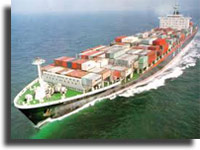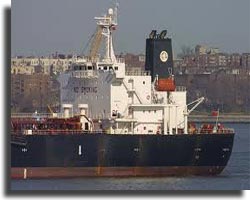| Size of the Industry | 515 vessels with a grt of 7.06 million |
| Geographical distribution | The major ports are located at Calcutta/ Haldia, Chennai, Cochin, Ennore, Jawaharlal Nehru Port at Nhava Sheva, Kandla, Mormugao, Mumbai, New Mangalore, Paradip, Tuticorin and Vishakhapatnam. |
| Output per annum | 42% of total Indian tonnage |
| Percentage In World Market | 8% of entire world trade |

The Indian Shipping industry is governed by 3 separate Acts such as The Merchant Shipping Act in 1958, The Inland Vessels Act in 1917 & The Coasting Vessels Act in 1838. Most of the vessels are registered under Merchant Shipping Act and are dealt within the sector, smaller barges and coastal vessels are governed by the other two Acts.
Terms and in value terms, it is much lower to a meager 12% of India's total overseas shipping bill of USD 5.0 billion. It is due to the negligible share of shipowners in the Indian trade of high value goods like general cargo and containers. The focus is on Indian trade and shipowners' share in the country's overseas trade is hardly 30% in volume.
Shipping Industry is meaning not only just vessels and tonnage. Shipping capabilities of any country are not solely measured in terms of the quantum of tonnage under control. While in knowledge based economy, soft intangible parameters like human capital, information technology and expertise are becoming increasingly important for increasing innumerable opportunities. Today India has become the source of quality seafarers to global shipowners. Indian shipping firms normally rely on the inherent IT skills of Indians to play a pivotal role in IT activity involved in international shipping and the country can come up with a business center for information processing requirements of the international ship owners.
Usage of sea transport for the bulk cargo transport is the natural advantage of a vast coastline of India. Due to the policy of liberalization, the Indian shipping industry, major ports, as road ways have been given to the private sector. The categories of ships are crude tanker, product tanker, bulk carriers, etc. All these are brought under the Open General License (OGL) to facilitate acquisition at competitive price.
For acquisition of such companies the Automatic approval is also available even for the categories which are not covered under OGL i.e. barges, tugs and boats, etc. Shipping companies have been given liberty to retain sale proceeds of their ships abroad and utilize them for fresh acquisition.
Approval for Foreign direct investment up to 74% is also provided by the Time Charter of ships by Indian Shipping Companies. 140 shipping companies were in operation in India at the end of March 2003, with the Shipping Corporation of India being the biggest in the country claiming a 42% share of the total Indian tonnage. The country presently has 12 major ports, 184 other ports, nine shipyards and a coastline of 7517 km.

- Ultratech Cement
- State-owned Shipping Corporation of India (SCI),
- The private sector Great Eastern Shipping have mixed fleets.
- Essar Shipping focuses on the energy trade and mainly operates tankers.
- Gujarat Ambuja Cement Limited
- Chowgule Shipping with Bulk Cargoes like Iron ore, coal, grain and fertilizers.
- Varun Shipping Company is mainly into wet, dry bulk, gas and chemical transport sectors.
In recent times the importance of Indian Navy in the high seas has never been felt so much because of the ongoing piracy activities off the Somalian Coast. Indian shipping industry contributed 8% of the entire world trade in terms of volume, which was the contribution of nominal 1.3% in monetary terms.India and China were in the same position 30 years ago, but today China has raced ahead in the field. Of the $30 billion freight market in India; only 8% of freight of Indian flagged ships is carried. There is a lot of scope for growth in that area too.
 Recent Press Release
Recent Press Release
 INDIAN Shipping INDUSTRY AT A Glance IN 2021 - 2022
INDIAN Shipping INDUSTRY AT A Glance IN 2021 - 2022
 INDIAN Shipping INDUSTRY AT A Glance IN 2020 - 2021
INDIAN Shipping INDUSTRY AT A Glance IN 2020 - 2021
 INDIAN Shipping INDUSTRY AT A Glance IN 2019 - 2020
INDIAN Shipping INDUSTRY AT A Glance IN 2019 - 2020
 INDIAN Shipping INDUSTRY AT A Glance IN 2018 - 2019
INDIAN Shipping INDUSTRY AT A Glance IN 2018 - 2019
 INDIAN Shipping INDUSTRY AT A Glance IN 2017 - 2018
INDIAN Shipping INDUSTRY AT A Glance IN 2017 - 2018
 INDIAN Shipping INDUSTRY AT A Glance IN 2016 - 2017
INDIAN Shipping INDUSTRY AT A Glance IN 2016 - 2017
 INDIAN Shipping INDUSTRY AT A Glance IN 2015 - 2016
INDIAN Shipping INDUSTRY AT A Glance IN 2015 - 2016
 INDIAN Shipping INDUSTRY AT A Glance IN 2014 - 2015
INDIAN Shipping INDUSTRY AT A Glance IN 2014 - 2015
 INDIAN Shipping INDUSTRY AT A Glance IN 2013 - 2014
INDIAN Shipping INDUSTRY AT A Glance IN 2013 - 2014
 INDIAN Shipping INDUSTRY AT A Glance IN 2012 - 2013
INDIAN Shipping INDUSTRY AT A Glance IN 2012 - 2013
 INDIAN Shipping INDUSTRY AT A Glance IN 2011 - 2012
INDIAN Shipping INDUSTRY AT A Glance IN 2011 - 2012
Indian Industries
 |
INDIAN INDUSTRIES |



 INDIAN SHIPPING INDUSTRY
INDIAN SHIPPING INDUSTRY